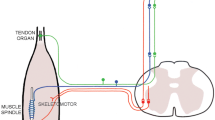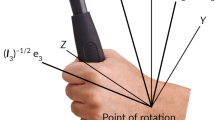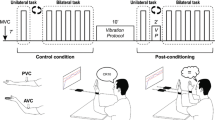Abstract
When humans handle a tool, such as a tennis racket or hammer, for the first time, they often wield it to determine its inertial properties. The mechanisms that contribute to perception of inertial properties are not fully understood. The present study’s goal was to investigate how proprioceptive afferents contribute to effortful perception of heaviness and length of a manually wielded object in the absence of vision. Blindfolded participants manually wielded specially designed objects with different mass, the static moment, and the moment of inertia at different wrist angles and angular kinematics. These manipulations elicited different tonic and rhythmic activity levels in the muscle spindles of the wrist, allowing us to relate differences in muscle activity to perceptual judgments of heaviness and length. Perception of heaviness and length depended on an object’s static moment and the moment of inertia, respectively. Manipulations of wrist angle and angular kinematics affected perceived heaviness and length in distinct ways. Ulnar deviation resulted in an object being perceived heavier but shorter. Compared to static holding, wielding the object resulted in it being perceived heavier but wielding did not affect perceived length. These results suggest that proprioceptive afferents differentially contribute to effortful perception of object heaviness and length. Critically, the role of afferent is specific to the mechanical variable used to derive a given object property. These findings open a new possibility of studies on the link between physiology, and different mechanical variables picked up by the perceptual system.



Similar content being viewed by others
References
Al-Falahe NA, Nagaoka M, Vallbo AKEB (1990) Response profiles of human muscle: afferents during active finger movements. Brain 113:325–346. https://doi.org/10.1093/brain/113.2.325
Amazeen EL, Turvey MT (1996) Weight perception and the haptic size–weight illusion are functions of the inertia tensor. J Exp Psychol Hum Percept Perform 22:213–232. https://doi.org/10.1037/0096-1523.22.1.213
Amazeen EL, Tseng PH, Valdez AB, Vera D (2011) Perceived heaviness is influenced by the style of lifting. Ecol Psychol 23:1–18. https://doi.org/10.1080/10407413.2011.539100
Aniss AM, Gandevia SC, Milne RJ (1988) Changes in perceived heaviness and motor commands produced by cutaneous reflexes in man. J Physiol 397:113–126. https://doi.org/10.1113/jphysiol.1988.sp016991
Blemker SS, Pinsky PM, Delp SL (2005) A 3D model of muscle reveals the causes of nonuniform strains in the biceps brachii. J Biomech 38:657–665. https://doi.org/10.1016/j.jbiomech.2004.04.009
Brooks J, Allen TJ, Proske U (2013) The senses of force and heaviness at the human elbow joint. Exp Brain Res 226:617–629. https://doi.org/10.1007/s00221-013-3476-6
Burnham KP, Anderson DR (2002) Model selection and multimodel inference: a practical information-theoretic approach. Springer-Verlag, New York
Carello C, Turvey MT (2000) Rotational invariance and dynamic touch. In: Heller MA (ed) Touch, representation and blindness. Oxford University Press, New York, pp 27–66
Carello C, Fitzpatrick P, Domaniewicz I et al (1992) Effortful touch with minimal movement. J Exp Psychol Hum Percept Perform 18:290–302. https://doi.org/10.1037/0096-1523.18.1.290
Carello C, Kinsella-Shaw J, Amazeen EL, Turvey MT (2006) Peripheral neuropathy and object length perception by effortful (dynamic) touch: a case study. Neurosci Lett 405:159–163. https://doi.org/10.1016/j.neulet.2006.06.047
Fallon JB, Macefield VG (2007) Vibration sensitivity of human muscle spindles and golgi tendon organs. Muscle Nerve 36:21–29. https://doi.org/10.1002/mus.20796
Feys J (2016) Nonparametric tests for the interaction in two-way factorial designs using R. R J 8:367–378
Fitzpatrick P, Carello C, Turvey MT (1994) Eigenvalues of the inertia tensor and exteroception by the “muscular sense.” Neuroscience 60:551–568. https://doi.org/10.1016/0306-4522(94)90264-X
Frost JJ, Pienta KJ, Coffey DS (2017) Symmetry and symmetry breaking in cancer: a foundational approach to the cancer problem. Oncotarget 9(14):11429–11440
Fultot M, Adrian Frazier P, Turvey MT, Carello C (2019) What are nervous systems for? Ecol Psychol 31:218–234. https://doi.org/10.1080/10407413.2019.1615205
Gandevia SC, McCloskey DI (1977a) Sensations of heaviness. Brain 100:345–354. https://doi.org/10.1093/brain/100.2.345
Gandevia SC, McCloskey DI (1977b) Effects of related sensory inputs on motor performances in man studied through changes in perceived heaviness. J Physiol 272:653–672. https://doi.org/10.1113/jphysiol.1977.sp012065
Gandevia SC, McCloskey DI (1977c) Changes in motor commands, as shown by changes in perceived heaviness, during partial curarization and peripheral anaesthesia in man. J Physiol 272:673–689. https://doi.org/10.1113/jphysiol.1977.sp012066
Gibson JJ (1979) The ecological approach to visual perception. Houghton Mifflin, Boston
Gurfinkel VS, Kots YM, Krinskiy VI et al (1971) Concerning tuning before movement. In: Gelfand IM, Gurfinkel VS, Fomin SV, Tsetlin ML (eds) Models of the structural-functional organization of certain biological systems. MIT Press, Cambridge, pp 361–372
Henry CA, McNulty IM, Durst WA et al (2005) Interactions between muscle fibers and segment boundaries in zebrafish. Dev Biol 287:346–360. https://doi.org/10.1016/j.ydbio.2005.08.049
Hurvich CM, Tsai C-L (1989) Regression and time series model selection in small samples. Biometrika 76:297–307. https://doi.org/10.1093/biomet/76.2.297
Hurvich CM, Tsai C-L (1995) Model selection for extended quasi likelihood models in small samples. Biometrics 51:1077–1084. https://doi.org/10.2307/2533006
Ingber DE (2006) Cellular mechanotransduction: putting all the pieces together again. FASEB J 20:811–827. https://doi.org/10.1096/fj.05-5424rev
Kandel ER, Schwartz JH, Jessell TM et al (2000) Principles of neural science. McGraw-Hill, New York
Kelty-Stephen DG, Eddy CL (2015) Self-trained perception need not be veridical: Striking can exaggerate judgment by wielding and can transfer exaggeration to new stimuli. Atten Percept Psychophys 77:1854–1862. https://doi.org/10.3758/s13414-015-0947-9
Kingma I, Beek PJ, van Dieën JH (2002) The inertia tensor versus static moment and mass in perceiving length and heaviness of hand-wielded rods. J Exp Psychol Hum Percept Perform 28:180–191. https://doi.org/10.1037/0096-1523.28.1.180
Kingma I, van de Langenberg R, Beek PJ (2004) Which mechanical invariants are associated with the perception of length and heaviness of a nonvisible handheld rod? Testing the inertia tensor hypothesis. J Exp Psychol Hum Percept Perform 30:346–354. https://doi.org/10.1037/0096-1523.30.2.346
Latash ML (1993) Control of human movement. Human Kinetics, Champaign
Latash ML (2020) On primitives in motor control. Mot Control 24:318–346. https://doi.org/10.1123/mc.2019-0099
Lederman SJ, Ganeshan SR, Ellis RE (1996) Effortful touch with minimum movement: revisited. J Exp Psychol Hum Percept Perform 22:851–868. https://doi.org/10.1037/0096-1523.22.4.851
Lu X, Yao X, Thompson WF, Hu L (2020) Three distinct neural mechanisms support movement-induced analgesia. bioRxiv. https://doi.org/10.1101/2020.05.14.097261
Luu BL, Day BL, Cole JD, Fitzpatrick RC (2011) The fusimotor and reafferent origin of the sense of force and weight. J Physiol 589:3135–3147. https://doi.org/10.1113/jphysiol.2011.208447
Maddaluno O, Guidali G, Zazio A et al (2020) Touch anticipation mediates cross-modal Hebbian plasticity in the primary somatosensory cortex. Cortex 126:173–181. https://doi.org/10.1016/j.cortex.2020.01.008
Mangalam M, Kelty-Stephen DG (2020) Multiplicative-cascade dynamics supports whole-body coordination for perception via effortful touch. Hum Mov Sci 70:102595. https://doi.org/10.1016/j.humov.2020.102595
Mangalam M, Barton SA, Wagman JB et al (2017) Perception of the length of an object through dynamic touch is invariant across changes in the medium. Atten Percept Psychophys 79:2499–2509. https://doi.org/10.3758/s13414-017-1403-9
Mangalam M, Conners JD, Fragaszy DM, Newell KM (2018a) Location of a grasped object’s effector influences perception of the length of that object via dynamic touch. Exp Brain Res 236:2107–2121. https://doi.org/10.1007/s00221-018-5287-2
Mangalam M, Wagman JB, Newell KM (2018b) Temperature influences perception of the length of a wielded object via effortful touch. Exp Brain Res 236:505–516. https://doi.org/10.1007/s00221-017-5148-4
Mangalam M, Carver NS, Kelty-Stephen DG (2020a) Global broadcasting of local fractal fluctuations in a bodywide distributed system supports perception via effortful touch. Chaos Solitons Fractals 135:109740. https://doi.org/10.1016/j.chaos.2020.109740
Mangalam M, Carver NS, Kelty-Stephen DG (2020b) Multifractal signatures of perceptual processing on anatomical sleeves of the human body. J R Soc Interface 17:20200328. https://doi.org/10.1098/rsif.2020.0328
Mangalam M, Chen R, McHugh TR et al (2020c) Bodywide fluctuations support manual exploration: fractal fluctuations in posture predict perception of heaviness and length via effortful touch by the hand. Hum Mov Sci 69:102543. https://doi.org/10.1016/j.humov.2019.102543
Michaels CF, Weier Z, Harrison SJ (2007) Using vision and dynamic touch to perceive the affordances of tools. Perception 36:750–772. https://doi.org/10.1068/p5593
Pagano CC, Cabe PA (2003) Constancy in dynamic touch: length perceived by dynamic touch is invariant over changes in media. Ecol Psychol 15:1–17. https://doi.org/10.1207/S15326969ECO1501_01
Pagano CC, Donahue KG (1999) Perceiving the lengths of rods wielded in different media. Percept Psychophys 61:1336–1344. https://doi.org/10.3758/BF03206184
Palatinus Z, Dixon JA, Kelty-Stephen DG (2013) Fractal fluctuations in quiet standing predict the use of mechanical information for haptic perception. Ann Biomed Eng 41:1625–1634. https://doi.org/10.1007/s10439-012-0706-1
Palatinus Z, Kelty-Stephen DG, Kinsella-Shaw J et al (2014) Haptic perceptual intent in quiet standing affects multifractal scaling of postural fluctuations. J Exp Psychol Hum Percept Perform 40:1808–1818. https://doi.org/10.1037/a0037247
Pinheiro J, Bates D, DebRoy S, et al (2018) nlme: linear and nonlinear mixed effects models. R Packag version 31–137
Profeta VLS, Turvey MT (2018) Bernstein’s levels of movement construction: a contemporary perspective. Hum Mov Sci 57:111–133. https://doi.org/10.1016/j.humov.2017.11.013
Proske U, Allen T (2019) The neural basis of the senses of effort, force and heaviness. Exp Brain Res 237:589–599. https://doi.org/10.1007/s00221-018-5460-7
Proske U, Gandevia SC (2012) The proprioceptive senses: their roles in signaling body shape, body position and movement, and muscle force. Physiol Rev 92:1651–1697. https://doi.org/10.1152/physrev.00048.2011
Rouder JN, Morey RD, Speckman PL, Province JM (2012) Default Bayes factors for ANOVA designs. J Math Psychol 56:356–374. https://doi.org/10.1016/j.jmp.2012.08.001
Sakamoto T, Kondo T (2017) Awareness of movement does not facilitate robot-assisted passive motor learning. Adv Robot 31:24–28. https://doi.org/10.1080/01691864.2016.1249026
Savelberg HHCM, Willems PJB, Baan GC, Huijing PA (2001) Deformation and three-dimensional displacement of fibers in isometrically contracting rat plantaris muscles. J Morphol 250:89–99. https://doi.org/10.1002/jmor.1061
Siebert T, Rode C, Till O et al (2016) Force reduction induced by unidirectional transversal muscle loading is independent of local pressure. J Biomech 49:1156–1161. https://doi.org/10.1016/j.jbiomech.2016.02.053
St MR, Talebkhah KS (2018) Neurological evidence of a mind-body connection: mindfulness and pain control. Am J Psychiatry Resid J 13:2–5. https://doi.org/10.1176/appi.ajp-rj.2018.130401
Streit M, Shockley K, Riley MA (2007a) Rotational inertia and multimodal heaviness perception. Psychon Bull Rev 14:1001–1006. https://doi.org/10.3758/BF03194135
Streit M, Shockley K, Riley MA, Morris AW (2007b) Rotational kinematics influence multimodal perception of heaviness. Psychon Bull Rev 14:363–367. https://doi.org/10.3758/BF03194078
Taylor AM, Christou EA, Enoka RM (2003) Multiple features of motor-unit activity influence force fluctuations during isometric contractions. J Neurophysiol 90:1350–1361. https://doi.org/10.1152/jn.00056.2003
Team RC (2013) R: A language and environment for statistical computing. Comput 1. https://doi.org/10.1890/0012-9658(2002)083[3097:CFHIWS]2.0.CO;2
Thomas BJ, Riley MA, Wagman JB (2019) Information and its detection: The consequences of Gibson’s theory of information pickup. In: Wagman JB, Blau JJC (eds) Perception as information detection: reflections on Gibson’s ecological approach to visual perception. Routledge, New York, pp 237–252
Turvey MT, Carello C (2011) Obtaining information by dynamic (effortful) touching. Philos Trans R Soc Lond B Biol Sci 366:3123–3132. https://doi.org/10.1098/rstb.2011.0159
Turvey MT, Fonseca ST (2014) The medium of haptic perception: a tensegrity hypothesis. J Mot Behav 46:143–187. https://doi.org/10.1080/00222895.2013.798252
Turvey MT, Burton G, Amazeen EL et al (1998) Perceiving the width and height of a hand-held object by dynamic touch. J Exp Psychol Hum Percept Perform 24:35–48. https://doi.org/10.1037/0096-1523.24.1.35
Turvey MT, Shockley K, Carello C (1999) Affordance, proper function, and the physical basis of perceived heaviness. Cognition 73:B17–B26. https://doi.org/10.1016/S0010-0277(99)00050-5
van de Langenberg R, Kingma I, Beek PJ (2006) Mechanical invariants are implicated in dynamic touch as a function of their salience in the stimulus flow. J Exp Psychol Hum Percept Perform 32:1093–1106. https://doi.org/10.1037/0096-1523.32.5.1093
von Holst E, Mittelstaedt H (1950) Das reafferenzprinzip. Naturwissenschaften 37:464–476. https://doi.org/10.1007/BF00622503
Waddell ML, Amazeen EL (2017) Evaluating the contributions of muscle activity and joint kinematics to weight perception across multiple joints. Exp Brain Res 235:2437–2448. https://doi.org/10.1007/s00221-017-4979-3
Waddell ML, Amazeen EL (2018) Lift speed moderates the effects of muscle activity on perceived heaviness. Q J Exp Psychol 71:2174–2185. https://doi.org/10.1177/1747021817739784
Waddell ML, Fine JM, Likens AD et al (2016) Perceived heaviness in the context of Newton’s Second Law: combined effects of muscle activity and lifting kinematics. J Exp Psychol Hum Percept Perform 42:363–374. https://doi.org/10.1037/xhp0000151
Wagman JB, Carello C (2003) Haptically creating affordances: the user-tool interface. J Exp Psychol Appl 9:175–186. https://doi.org/10.1037/1076-898X.9.3.175
Yuan C, Arora A, Garofalo AM, Grange RW (2021) Potential cross-talk between muscle and tendon in Duchenne muscular dystrophy. Connect Tissue Res 62:40–52. https://doi.org/10.1080/03008207.2020.1810247
Author information
Authors and Affiliations
Contributions
MM conceived and designed research; MM performed experiments; MM and ND analyzed data; MM, ND, and DGK-S interpreted results of experiments; MM prepared figures; MM drafted manuscript; MM, ND, and DGK-S edited and revised manuscript; MM, ND, and DGK-S approved final version of manuscript.
Corresponding author
Ethics declarations
Conflict of interest
The authors declare that no competing interests exist.
Additional information
Communicated by Melvyn A. Goodale.
Publisher's Note
Springer Nature remains neutral with regard to jurisdictional claims in published maps and institutional affiliations.
Rights and permissions
About this article
Cite this article
Mangalam, M., Desai, N. & Kelty-Stephen, D.G. Proprioceptive afferents differentially contribute to effortful perception of object heaviness and length. Exp Brain Res 239, 1085–1098 (2021). https://doi.org/10.1007/s00221-021-06045-4
Received:
Accepted:
Published:
Issue Date:
DOI: https://doi.org/10.1007/s00221-021-06045-4




